
When we hear the term "biohazard," it might conjure images of a lab experiment gone wrong or a movie scene featuring hazardous materials. In reality, biohazards are much closer to home than most people realize—and they often require immediate attention to ensure safety.
At Bio-One Fremont, we specialize in addressing biohazard situations, providing expert cleanup services to restore spaces to safety and normalcy throughout the San Francisco Bay Area (Alameda, Santa Clara, San Mateo, San Francisco) and surrounding counties (Contra Costa, San Joaquin, Sonoma, Napa, Vallejo). But what exactly qualifies as a biohazard, and why is professional cleanup so important?
A biohazard, short for biological hazard, refers to any biological substance that poses a risk to human or animal health. These hazards can spread disease, contaminate environments, and create significant health risks if not properly handled and decontaminated.
Common biohazards include:
Bio-One Fremont specializes in cleaning and restoring spaces affected by a wide range of biohazard scenarios. Here’s a closer look at the services we provide:
The emotional toll of these situations is immense, and the cleanup process can be just as overwhelming. We handle these cases with compassion and discretion, ensuring the area is thoroughly cleaned and decontaminated.
Whether due to accidents, medical emergencies, or trauma, blood spills require expert attention to remove biohazards and prevent contamination.
Human and animal waste can carry harmful pathogens, making proper removal and sanitization critical for safety. Whether it’s a one-time incident or part of a larger cleanup, we ensure thorough decontamination.
Hoarding situations often involve not just clutter but also biohazards such as mold, animal droppings, and pests. We handle these complex cases with sensitivity and care.
Odors from hoarding, spoiled food, feces, cigarette smoke, marijuana smoke, and other sources can linger and create unlivable environments. We use specialized techniques and equipment to neutralize odors at their source, ensuring a fresh, clean space.
Mold isn’t just unsightly—it can trigger respiratory problems and exacerbate allergies. We identify and remove mold to ensure a safe and healthy space.
Handling biohazards isn’t just a cleaning task—it’s a critical health and safety measure. Attempting to clean up biohazards without proper training and equipment can expose you to harmful pathogens and increase the risk of contamination.
At Bio-One Fremont, we:
Biohazards are not just messes—they’re potential threats to health and safety. That’s why Bio-One Fremont is available 24/7 to respond to your needs with expertise, compassion, and professionalism.
If you’re dealing with a biohazard situation, don’t wait. Contact us today for a free, no-obligation quote. Call 925-369-3096 or visit BioOneFremont.com to learn more about how we can help.
Your safety is our priority. Let us handle the tough jobs so you can focus on moving forward.

When facing a biohazard cleanup, hoarding situation, or other challenging cleanup needs, uncertainty about costs can add unnecessary stress. That’s why at Bio-One Fremont, we take pride in offering free, no-obligation “Not To Exceed” quotes. This means the price we quote is the maximum you’ll pay—no lowball offers, no surprise add-ons after the job begins.
Here’s why our approach to quoting services is a game-changer and how it reflects our commitment to transparency, honesty, and exceptional customer care.
Cleaning up biohazards, hoarding environments, or infestations can involve many variables, making it impossible to accurately quote a job without seeing the space. By offering a free on-site inspection, we provide a detailed estimate that covers every aspect of the job.
And with our “Not To Exceed” promise, you can rest assured that the price you’re quoted is the highest you’ll pay. If the job ends up being simpler than expected, we’ll adjust the cost down—but we’ll never go above the quoted amount.
Unfortunately, some companies lure customers with low initial prices, only to tack on charges as the job progresses. At Bio-One Fremont, we believe this practice is unfair and unethical. Our “Not To Exceed” quotes eliminate this concern, giving you the confidence to move forward without fear of surprise charges.
Every cleanup situation is different, and we treat it as such. By conducting an on-site evaluation, we can create a tailored plan that addresses your specific challenges—whether it’s a biohazard, hoarding cleanup, or rodent infestation.
The result? A comprehensive and transparent estimate that reflects the scope of work required, with no guesswork involved.
Many of our clients reach out during emotionally challenging periods, such as the loss of a loved one or the discovery of a hazardous situation in their home. The last thing they need is added financial stress.
Our “Not To Exceed” quotes provide peace of mind by ensuring:
When we say “free quote,” we mean it. There’s no obligation to proceed with our services after receiving your estimate. Our goal is to empower you to make an informed decision without any sales pressure.
At Bio-One Fremont, we understand that trust is earned. By committing to “Not To Exceed” quotes, we demonstrate that we’re serious about delivering on our promises. This approach ensures you can focus on the cleanup process, not worry about unexpected costs.
If you’re facing a challenging cleanup and need expert assistance, contact Kevin Jameson and the Bio-One Fremont team. We’re available 24/7 to provide free, no-obligation “Not To Exceed” quotes and help you take the first step toward restoring your space.
Call us at 925-369-3096 or visit BioOneFremont.com to schedule your consultation today.
Compassion. Integrity. Results. That’s the Bio-One Fremont promise.
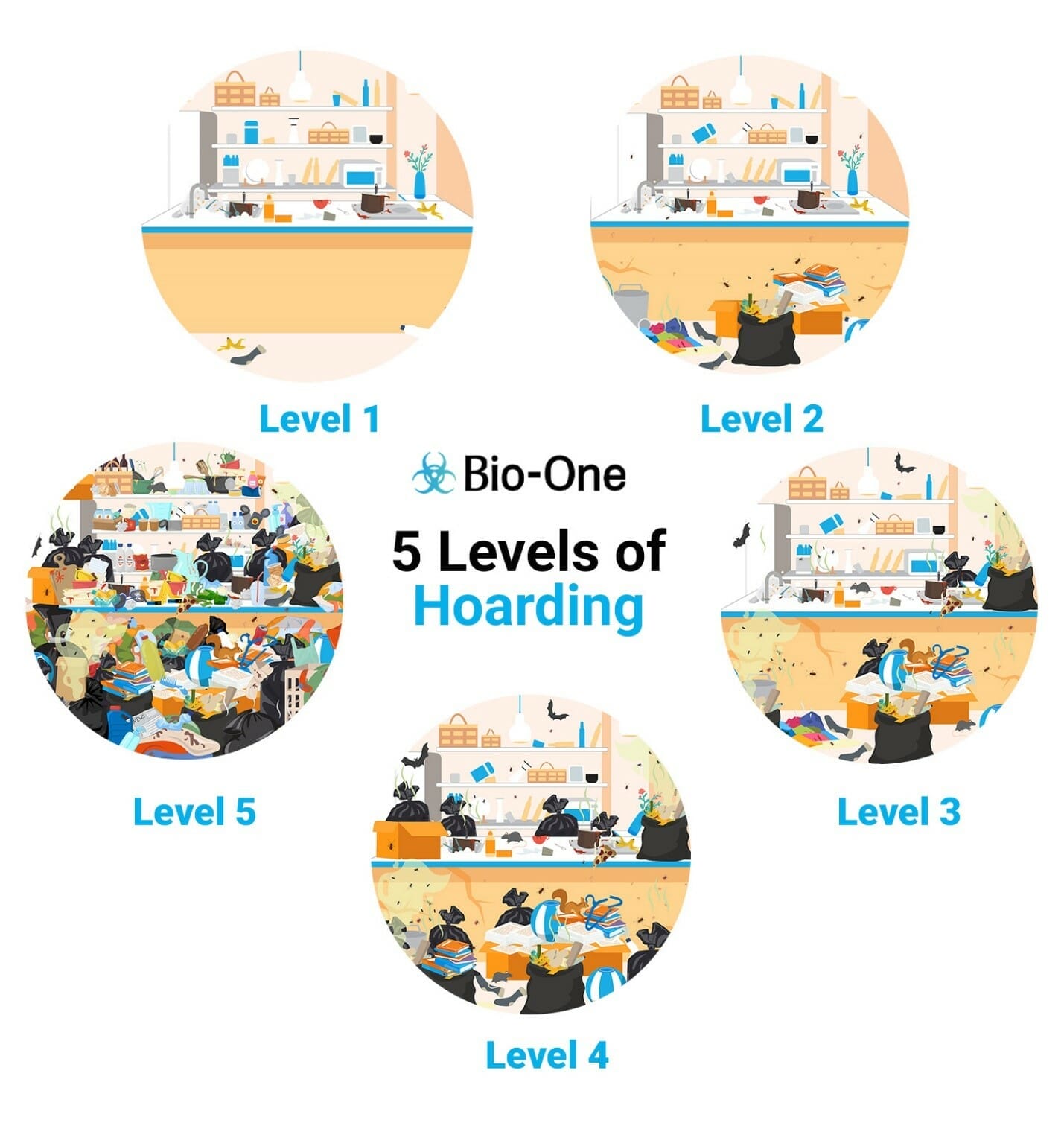
When we hear the word “hoarding,” many of us conjure up images from shows like Hoarders, which often portray extreme cases. However, hoarding behavior encompasses a spectrum, and not all individuals who struggle with it have homes filled to the brim with clutter.
The Institute for Challenging Disorganization has categorized hoarding behavior into five levels on their Clutter-Hoarding Scale. The Bio-One Fremont team has completed multiple training programs to better understand the root causes of hoarding situations and to support those clients who reach out for support.
Level 1 Hoarding
At Level 1, a home may not be spotless, but it remains easily accessible and sanitary. While there is clutter, safety concerns are minimal. Many of us find ourselves in Level 1 at some point, with clutter being a common aspect of daily life.
Here are the key characteristics of Level 1:
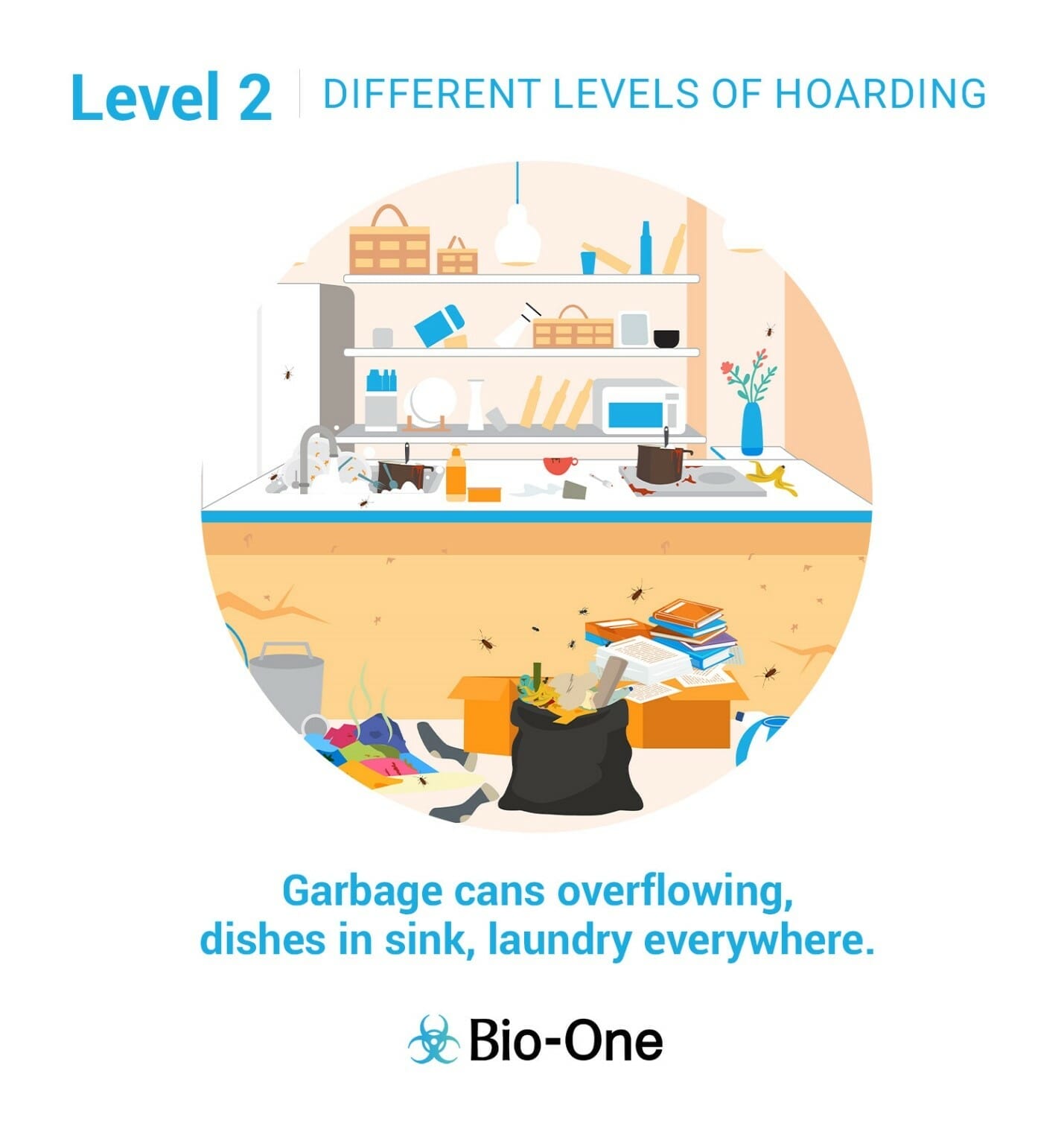
Level 2 Hoarding
Moving to Level 2, the home remains livable but shows signs of increased disarray. Cleaning becomes overdue, potentially overwhelming occupants. Hygiene levels may decline.
Key characteristics of Level 2 include:
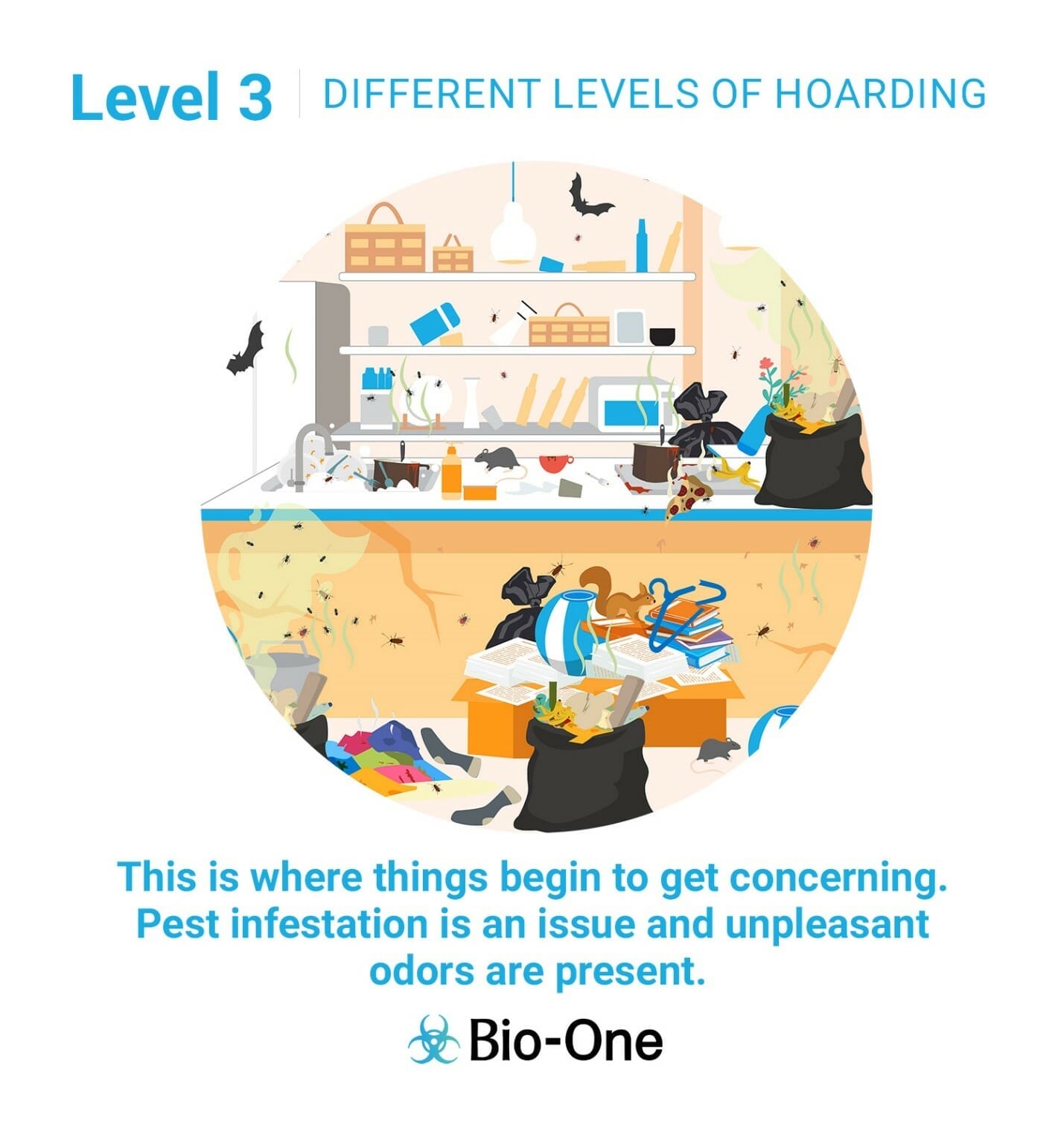
Level 3 Hoarding
Level 3 marks a significant transition, indicating more serious hoarding behavior and household disorganization.
Key characteristics of Level 3 include:
Level 3 households may benefit from seeking outside assistance, although concerted efforts from the family can also make a difference.
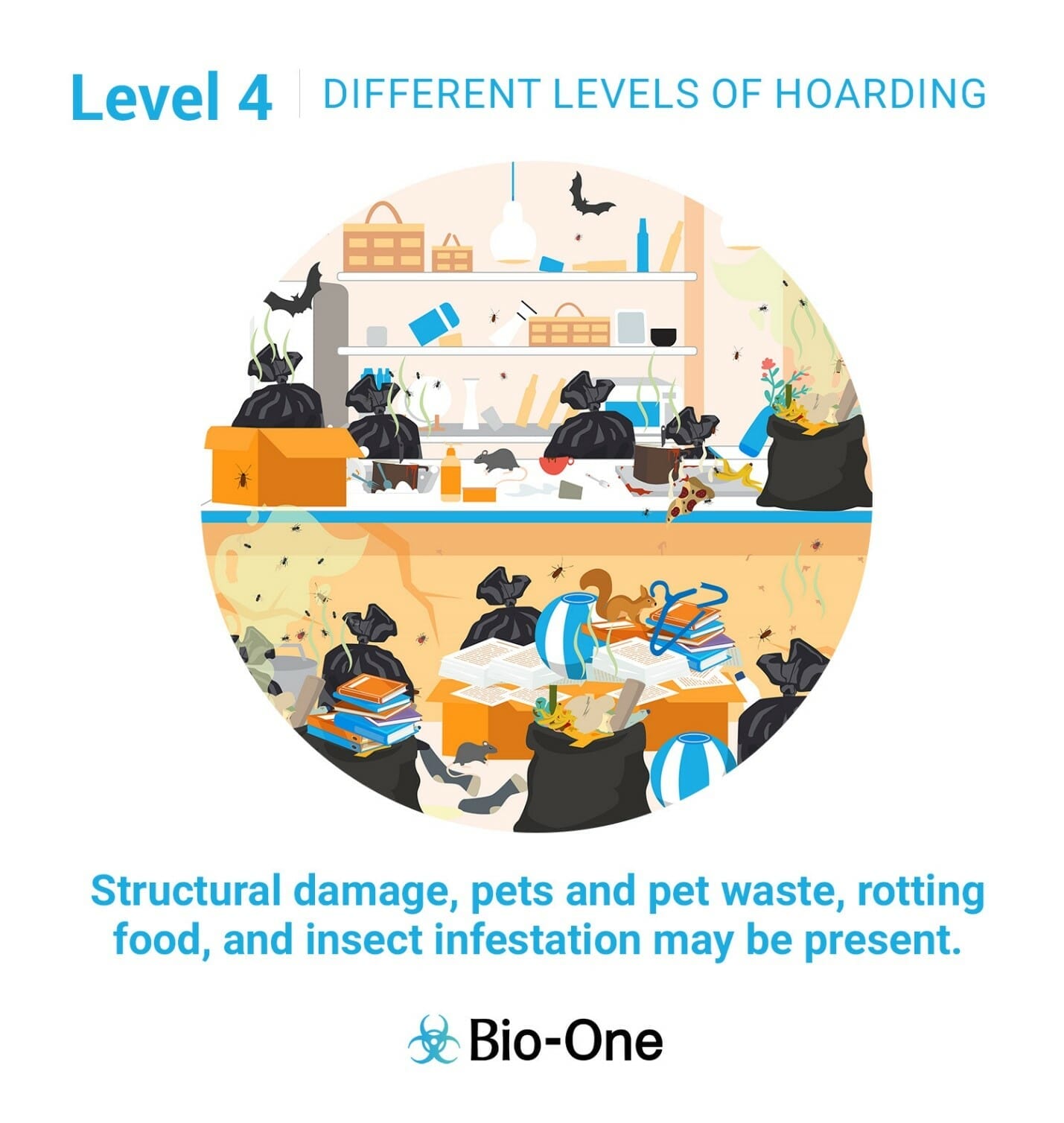
Level 4 Hoarding
At Level 4, excessive clutter dominates the home, necessitating professional intervention.
Key characteristics of Level 4 include:
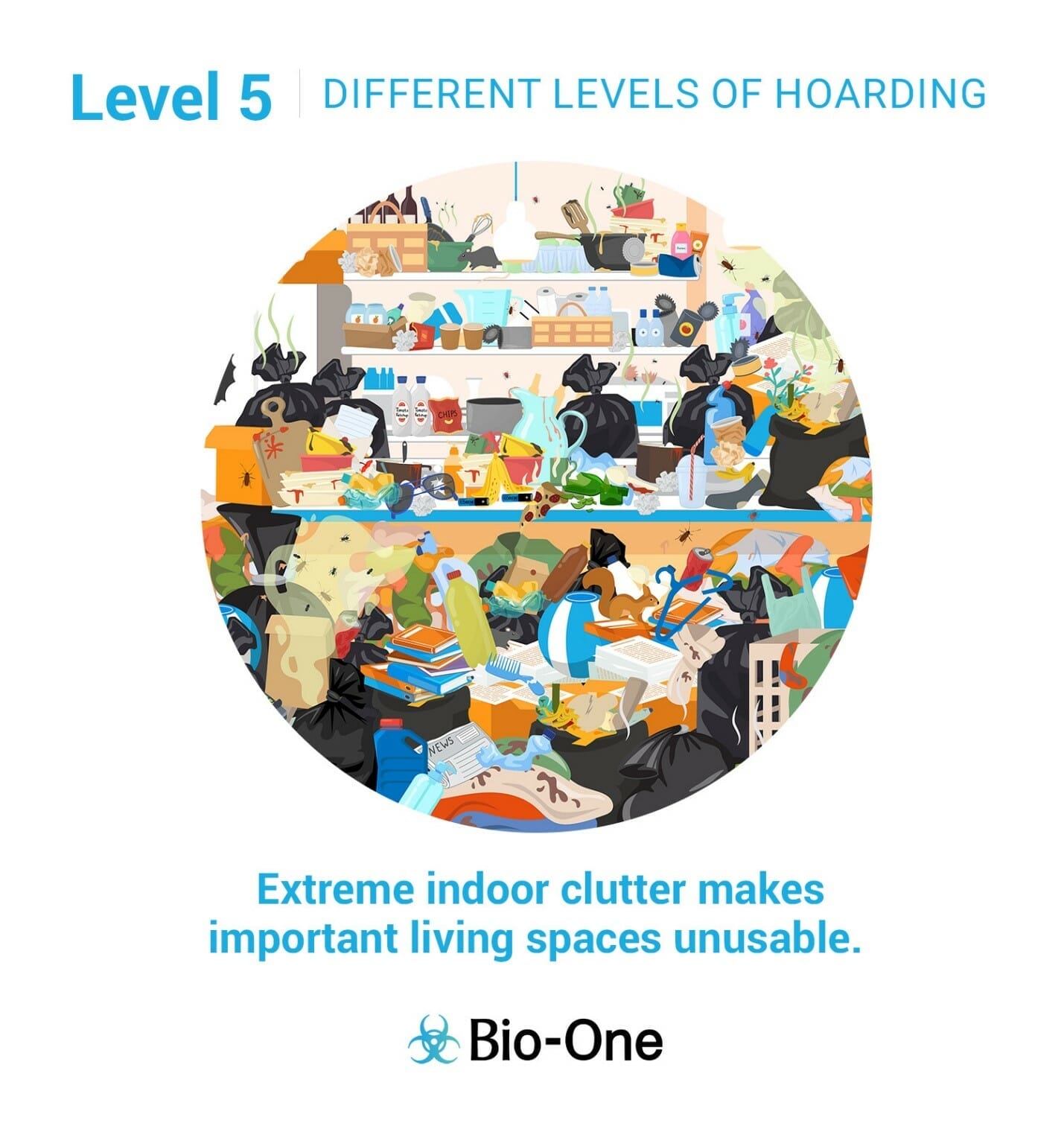
Level 5 Hoarding
Level 5 represents the highest level of hoarding behavior, presenting alarming hazards that require specialized expertise to address.
Key characteristics of Level 5 include:
If you or someone you know is struggling with hoarding behavior at any level, assistance is available. Visit https://bioonefremont or call (925) 369-3096 to speak with a certified specialist.
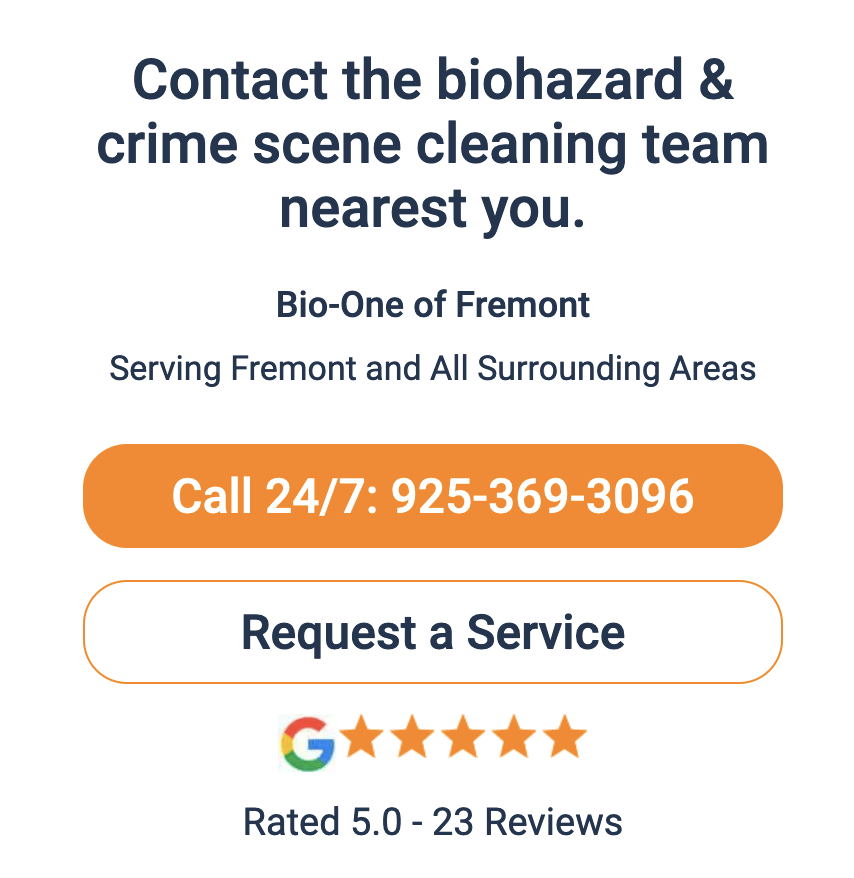
In challenging situations like biohazard cleanup or hoarding scenarios, understanding the costs involved is paramount. At Bio-One Fremont, we recognize the importance of transparency in pricing, and we're here to demystify our pricing structure for you.
A common query we receive over the phone is, "Can you tell me how much it will cost to…?" The truth is, every job location is unique in size, square footage, and degree of impact, making it difficult to provide a fixed cost upfront.
However, we are committed to providing clear answers to this question. Upon your request, Bio-One Fremont typically responds in under 60 minutes to your site to develop a detailed project plan and estimate – all at no charge to you.
Here's how we determine our pricing:
When you choose Bio-One Fremont, you can expect complete transparency and clarity in our pricing. We provide a detailed, line-item quote that comprehensively outlines our plan and associated costs. This empowers you to make informed decisions about our services with confidence.
Understanding that unforeseen expenses can be overwhelming, we offer financing options for every job. We firmly believe that everyone deserves access to the support they need without financial strain. Our financing options provide flexibility and peace of mind for our customers.
At Bio-One Fremont, our top priority is to deliver compassionate, professional, and effective services to our community. Our pricing structure reflects our unwavering commitment to providing high-quality results while ensuring transparency and affordability for our customers.
Should you have any further questions about our pricing or services, please don't hesitate to reach out. We're here to assist you every step of the way.

Fremont, CA - Family-owned and operated, Bio-One of Fremont is a leader in crime scene cleanup and biohazard decontamination services in Alameda, Contra Costa and Santa Clara Counties.
Whether you need help remediating a crime scene, suicide, or other trauma event in the San Francisco Bay Area, they are ready to answer the call.
Since joining the Bio-One family, Bio-One of Fremont has continually grown and provided a very valuable service to families around the Bay area.
The scenes they remediate are often overwhelming and dangerous, but the crew are trained and experienced and here for you. It is a wonderful service they provide.
Kevin Jameson, owner, states - "We hope you never need our service, but in the case of an unattended death, suicide, or a violent crime, Bio-one of Fremont is here to help families and loved ones so that they do not have to go through additional trauma of cleaning up. Our goal is to allow families to start the grieving and healing process while we restore the property for them".
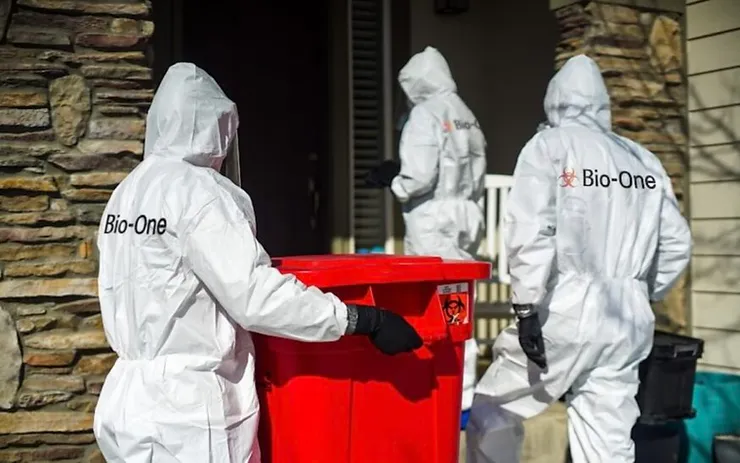
As a former crime scene technician, Kevin describes that when there is a death, only the body is removed and the family is left with the aftermath. That's where Bio-One helps. Using proper equipment to remove biohazards and medical waste safely in addition to proper PPE and hazmat suits, Bio-One allows the family to safely return to their home.
Most jobs are covered by homeowners insurance, and Bio-One of Fremont realizes that working with an insurance company can be overwhelming during difficult times. Bio-One of Fremont has dedicated staff who work directly with your insurance company from opening a claim to submitting all necessary documentation to close it upon completion.
"Anything trauma scene-related or death-related is typically covered by homeowners insurance so our clients only pay a deductible for our services"
Coordinating with the insurance company allows family members to focus on healing and supports Bio-One of Fremont's motto, "Help First, Business Second"!
A portion of their business is also hoarding. You can find a guide on their website.
They also provide cleaning for people with mental health or mobility issues. Bio-One of Fremont crew members are certified in Mental Health First Aid and have completed additional training with the San Francisco County Department of Mental Health to further assist their clients.
Additionally, Bio-One does cleanouts when residents or tenants leave behind a large mess or odors related to mold, cigarette and cannabis smoke.
Bio-One provides many services and resources which can be found on its website.
They answer the call 24/7 and are here to help you.
Their company vehicles are also unmarked for your privacy.
Bio-One of Fremont has a 5-star rating and have received numerous testimonials which can be found on their website.
Located in Fremont and Livermore, you can reach them by phone at 925-369-3096 or via email at mailto: info@bioonefremont.com
Find them on Facebook at www.facebook.com/bio.one.fremont or visit their website at www.bioonefremont.com.

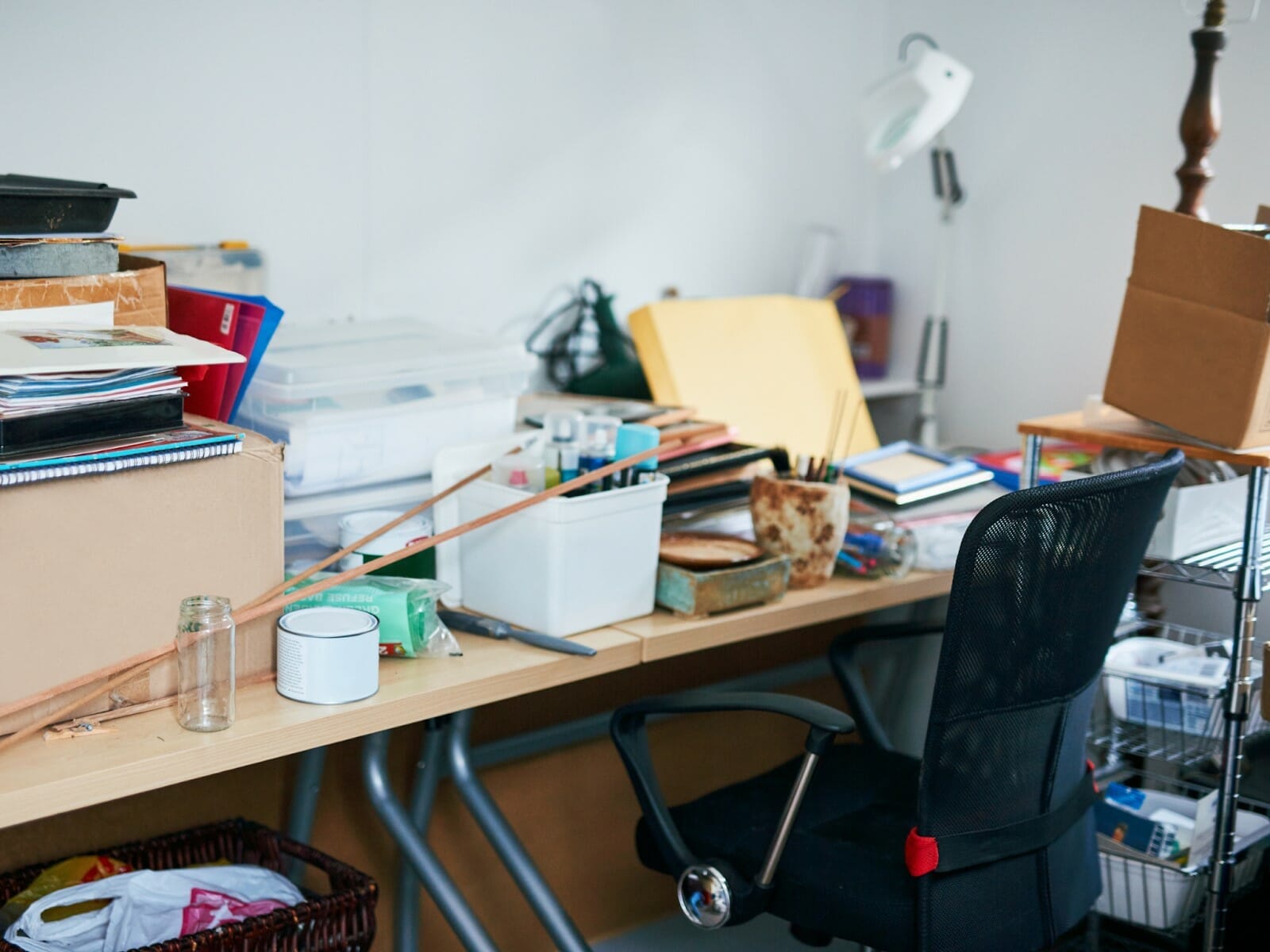
There are varied reasons people hang on to things they don’t need based on their circumstances or deeper-lying struggles. A cluttered home—even one that would qualify as a Level 5 situation—doesn’t stem from laziness or lack of willpower.
More often than not, a cluttered home is the result of a difficult-to-control situation, which is part of normal life.
What’s the source of your clutter? Following, are a few factors that may be contributing to your at-home clutter:
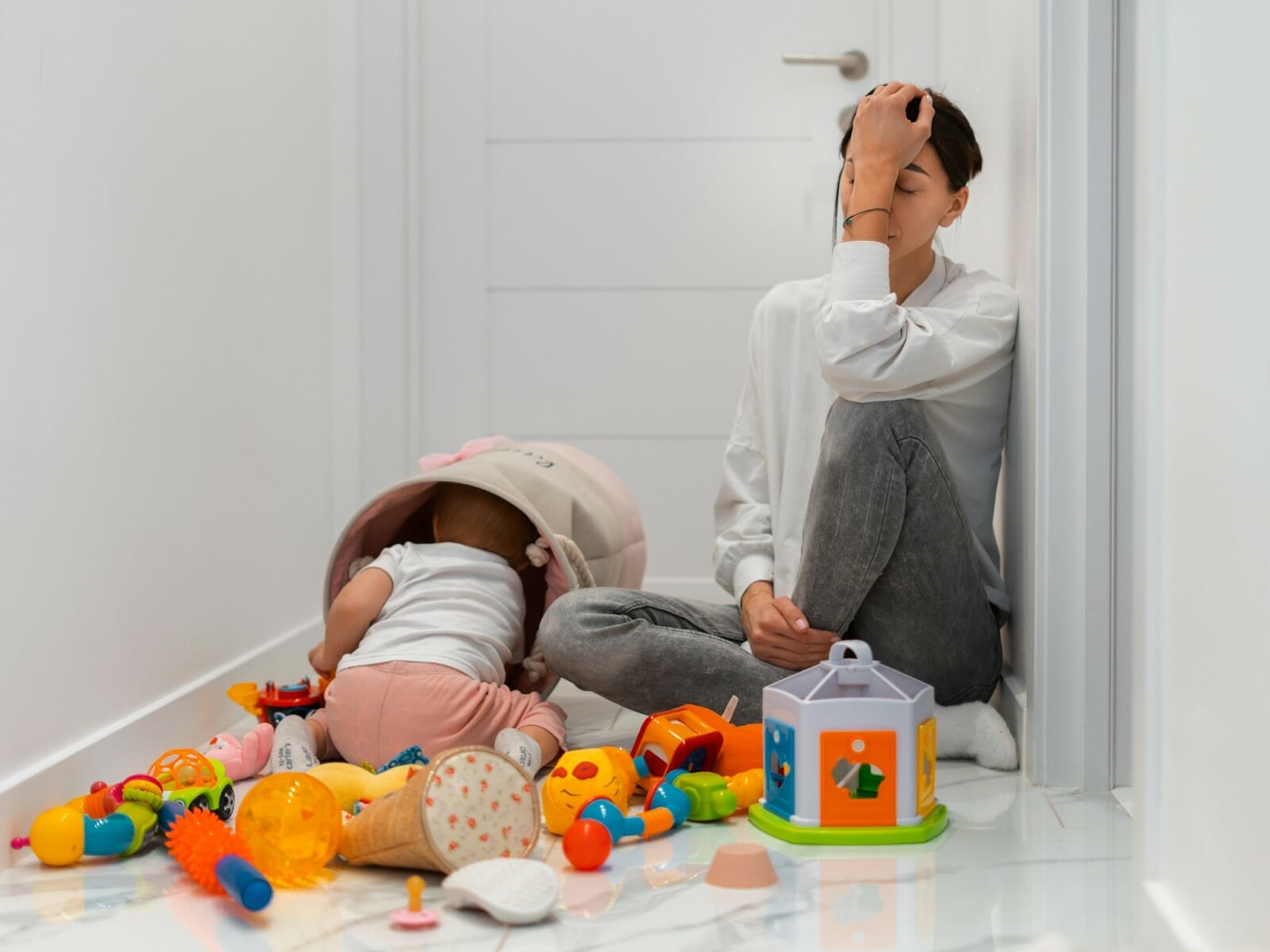
Having children can bring an abundance of joy, but also plenty of clutter.
Baby gear that is only used for a short period of time, rapidly changing clothes sizes, and piles of toys accumulate quickly.
It doesn’t end with the baby phase, though. As all guardians know, older kids and teens bring their own messes into the home.
Food-related messes combined with sleep deprivation can make it difficult to keep up with housework.
With children leaving clutter everywhere and food-related messes needing immediate care, it can be difficult to keep up with housework. Especially when you consider the sleep deprivation that also comes with kids.
Between art and science projects on the counter and smelly gym bags and laundry
left around the house, things can get (or stay!) messy.
It doesn’t help that children aren’t well-known for cleaning up after themselves!
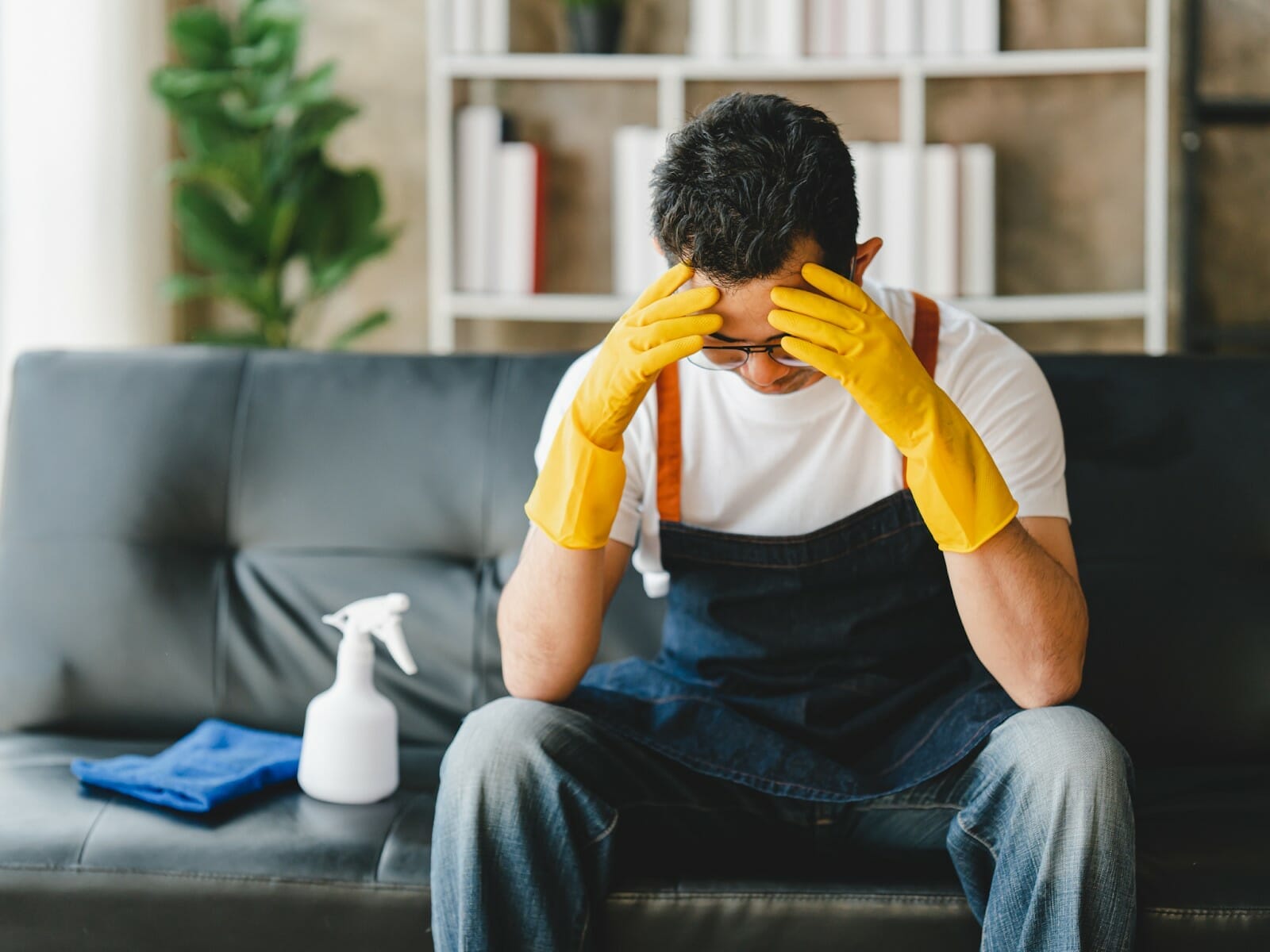
As adults age, they may struggle to keep up with their housework.
Think of all the reaching and bending over. Consider all the hard scrubbing. With health issues, simple cleaning tasks take much longer to accomplish, if it can still be done.
Decreased mobility and increased health issues can make cleaning overwhelming or even impossible.
In addition, it can be difficult to let go of possessions accumulated over a lifetime.
Anxiety can make it difficult to throw away possessions.
People with anxiety may hold on to items in excess in case of a feared emergency or indecision about what to do with items.
Finding the motivation to clean and declutter is often a struggle for someone suffering from depression.
The stress of an out-of-control home situation (whether it’s actually out of control
or simply perceived to be) can create a negative feedback loop.
For example, maybe you’re struggling with depression and lack the motivation to do the dishes. This means the dishes quickly pile up and within a week or two every surface in your kitchen could be covered in dirty dishes.
Now, you’re facing an overwhelming mess that can make you feel even worse—piling on exhaustion, guilt, and shame—and making you even less likely to find the motivation to clean up.
This cycle can leave those struggling with depression feeling more overwhelmed and less able to approach their home situation.
Individuals with ADHD often have intense, passionate interests and may accumulate items related to that interest. In addition, it can be difficult for a person with ADHD to create and stay focused on a plan for a big cleaning project. Anytime there are multiple steps involved, it’s easy for people with ADHD to get distracted.
Obsessive-compulsive disorder is characterized by obsessive, intrusive thoughts and compulsive behaviors. People with OCD sometimes deal with anxieties and emergencies by compulsively buying items. They may have obsessions about running out of essential items or a buying ritual that is difficult to break out of.

Trauma can be a trigger for accumulating clutter. If someone grew up without:
They may feel driven to hold onto things rather than throw them away when they are no longer needed. Research shows that childhood emotional abuse and physical neglect in particular predict higher levels of hoarding symptoms.
People who have experienced loss may also accumulate possessions to soothe the ache of missing their loved one. Buying new things triggers a brief dopamine high, bringing temporary emotional relief.

If you grew up in a home where clutter was common, you are more likely to show these behaviors yourself. You may have a genetic disposition toward it through related diagnoses like anxiety or depression. You may also be more used to an environment where clutter, mess, and even the higher levels of hoarding are the norm.

No matter the reason clutter starts, it’s normal to feel overwhelmed and stressed by the situation. Home maintenance is a big task under any conditions. Certain factors can make the situation feel impossible such as:
Stress can lead to disorganized homes, and disorganized homes can increase stress. Natalie Christine Dattilo, PhD, clinical health psychologist and instructor of psychiatry at Harvard Medical School, calls it a chicken-or-egg dilemma.

“Recent studies have shown that clutter in our homes is associated with higher cortisol levels [our stress hormone], but it’s still unclear which comes first,” says Dattilo.
“Is it that when we are under stress, our ability to maintain a well-organized home becomes impaired? Or when our home is in disarray, does that make us feel more stressed, overwhelmed, and anxious?”
Regardless of the root of the issue, there is a way out. Resources are available to help you deal with your home situation. Bio-One can help! Our services can help ease your stress. For more information on how we can help you with your clutter call (925) 369-3096.

The word “hoarding” probably evokes a particular image, made more common by shows like Hoarders that highlight extreme examples. In reality, not all hoarders have rooms full of items piled high to the ceiling.
The Institute for Challenging Disorganization (now, there’s a relatable title!) has classified hoarding behavior into five levels on their Clutter-Hoarding Scale.Level 1 Hoarding
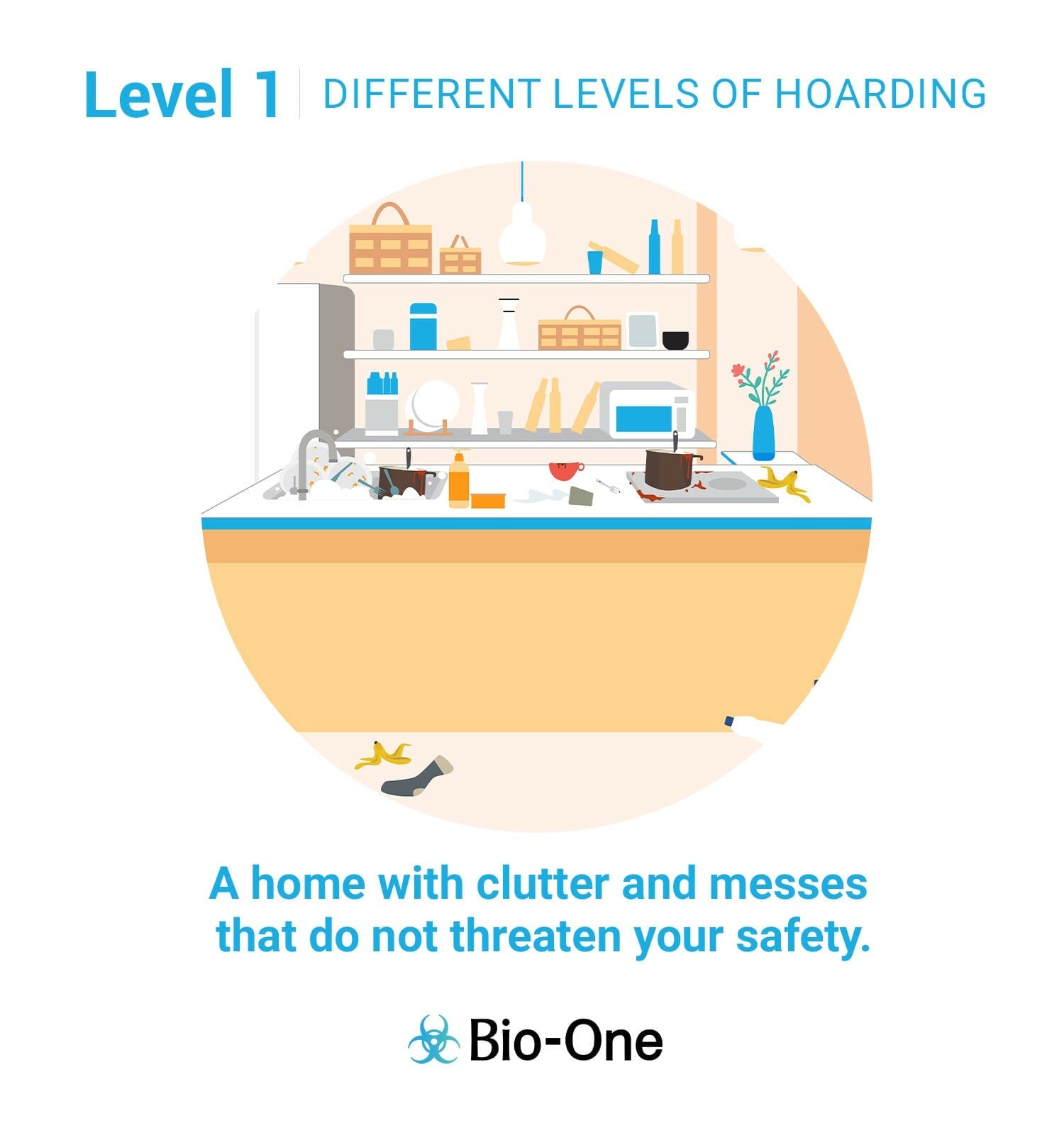
At Level 1, a home is not pristine, but the space is still easily accessible and sanitary. There is clutter, but no concern for safety. Most, if not all of us, have been in Level 1. Many people spend most of their time in this stage.
Here are the defining characteristics of this level:

At Level 2, the home is still very livable, but there’s more evidence of disarray. The home is in need of cleaning and may be starting to overwhelm the residents. The hygiene level isn’t optimal.
Most of us bounce between Level 1 and Level 2. However, here are the more defining characteristics of Level 2:

Level 3 is considered the turning point between manageable household disorganization and a more serious issue. Level 3 homes show extreme disorganization and indicate hoarding behavior.
Here are the defining characteristics of this level:
Level 3 households should consider hiring outside help. Although, it’s still possible to get it under control with a concerted effort from the whole family

At Level 4, the home shows excessive clutter.Those living in Level 4 conditions need professional help. At this level, part of getting help includes professional cleaning to transform the house into a safe, hygienic space where people can thrive. Mental health counselors and social workers may also step in to help residents change their habits.
Here are the defining characteristics of this level:

Level 5 is the highest level of hoarding behavior. Level 5 homes are alarmingly hazardous.
They require professionals with safety equipment and training to clean.
Here are the defining characteristics of this level:
If you or someone you know is struggling with these levels of hoarding we are here to help.
You can find more information at https://bioonefremont.com/ or contact us at (925) 369-3096

Bio-One teams across the U.S. answer calls to help their communities and remediate a variety of scenes. In our new blog series, we'd like to bring you into the Bio-One world by sharing stories of the unique and important work we do for local communities.
Here is Week 5 of our Bio-One Weekly Wrap-Up.
Chocolate Spill Makes for a Sweet Cleanup
In Scranton on March 25, Juan and Nicole Morales received a call for a "chocolate" cleanup. Assuming this was code for a sewage back-up, they rushed to scene to find a different situation entirely. Approximately 100 gallons of milk chocolate had spilled, covering asphalt outside a local business.
This is certainly the sweetest smelling job a Bio-One office has ever taken, but Nicole clarified, "That smell was nice for the first few minutes but at the end I felt sick. Good thing we had an awesome team that pushed through and got this done!"
After scraping the chocolate with a forklift and pressure washing the area, the Bio-One team received a five-star review. Well done!


Behind the Scenes with Citizen's Academy
Many Bio-One owners sign up for their local Citizen's Police Academy to acquaint themselves with the activities of their local police department. This week, Bio-One owner, Ginger Akemon, in Jacksonville, FL earned her Citizen's Police Academy certificate from the Clay County Sheriff's Office.
"Definitely a learning process. Each County has their own, my goal is to go to each county's classes. This was 10 weeks long and over an hour drive each way, but well worth it, " said Ginger.
Hoarding Transformation in Long Beach
In Long Beach, the Bio-One team has been working hard on several hoarding projects. These before and after pictures show the detail and expertise our teams bring to each job.

Have you ever seen hoarding shows on TV? Our team has first-hand experience remediating these situations with care and compassion. From clutter, trash, to animal hoarding, we understand that the removal of items can be stressful and sometimes overwhelming for families involved. Bio-One will make it a priority to establish trust to ensure everyone is comfortable and ready for each day to begin.
It's as simple as 1, 2, 3.
First, we always offer estimates at no cost to you. An experienced crew leader will tour the home and propose a plan based on your needs, expectations, and goals.
Second, our certified technicians are trained to be mindful of all possessions. We make it a priority to find and save items of value whether that's a wallet, coin collections, legal documents, photo albums, or baseball cards.
Third, we want to make sure you are 100% satisfied and happy with our work. If for some reason something else needs to be done, we are here for you.
Call Bio-One today to learn how we can help.

Bio-One teams across the U.S. answer calls to help their communities and remediate a variety of scenes. In our new blog series, we'd like to bring you into the Bio-One world by sharing stories of the unique and important work we do for local communities.
Here is Week 3 of our Bio-One Weekly Wrap-Up.
Five 30 Yard Dumpsters
The team in Pensacola has been working non-stop on a two story home that required Bio-One hoarding services. Over the course of five days, they filled five 30 yard dumpsters, and found multiple antique pieces, photographs, sentimental items and cash that was promptly turned over to the client.
Look through the transformation photos on their Facebook page!
Backing the Blue in Omaha
The Bio-One team in Omaha dropped off bagels at the Omaha Police Department just before roll call, and Vanessa Urbach, the civilian crime and prevention specialist, tweeted a "Thank You" with shoutouts to Bio-One. Joining the conversation was our own Bio-One Twitter handle, Deputy Chief Ken Kanger, host of the What's Up Omaha Podcast, and a number of other officers in the department.
Kudos to the Omaha team for backing the blue!
Safety First
Before Bio-One teams can help first, we have to ensure safety for every technician on the job site. This week, Bio-One owners took part in conversations about safety. Topics ranged from preventing common injuries on the job to attending OSHA training with Bob Easter. Jared Lafferty, Bio-One owner in Gwinnett County, even took the conversation to Twitter and featured safety protocols his team uses while on the job.
We couldn't be prouder of our teams for putting safety first!